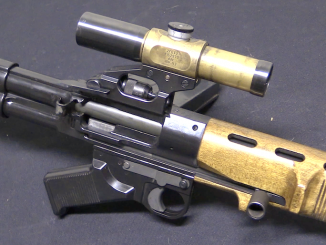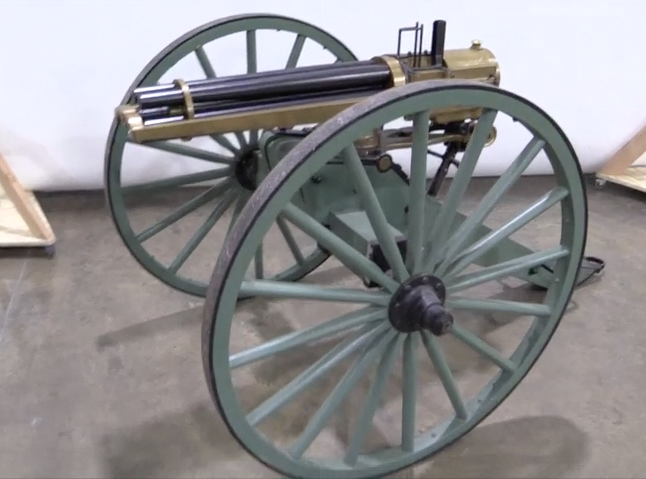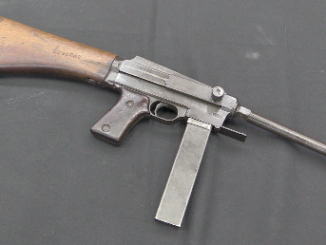This Hotchkiss machine gun and its tripod are lot #2027 in the upcoming April 2019 Morphy auction.
The gun that became the Hotchkiss 1914 and served as the bulwark of French and American forces in World war One was actually first designed and patented by an Austrian officer; Adolph von Odkolek. He took his idea to the Hotchkiss company in Paris hoping to arrange for them to produce it under license. The design was inspected by Laurence Benet (chief engineer at Hotchkiss) and Henri Mercie (Benet’s assistant), and they concluded that the gun was not suitable for production. However, the core concept in the patent – Odkolek’s gas piston system – was a worthy one and would allow production of machine guns to compete with Maxim and Colt without violating their existing patents. So Benet arranged to simply buy the patent outright for a flat fee, and then Hotchkiss set about redesigning the gun to be much better.
The result was the model 1897, an air-cooled, strip-fed heavy machine gun that was sold to many different nations. It was improved in 1900, and between the two models sales were made to Japan, Mexico, Chile, Brazil, China, Spain, Ethiopia, Finland, Greece, Guatemala, Luxembough, Norway, Sweden, Turkey, Portugal, and Venezuela in a variety of calibers. The French government also purchased some Hotchkiss guns, primarily for colonial use. For the bulk of the metropolitan army, France opted to design its own gun in the state arsenals (which was the Modele 1907 St Etienne gun; which is suspiciously like a Hotchkiss with the operating direction of the parts reversed to avoid patent infringement).
When World War One broke out, and the need for vast quantities of machine gun became apparent, the Hotchkiss was finally adopted on a large scale by France. The commercial 1900 pattern was revised slightly (a better barrel locking system and replacement of the shoulder stock with a D-ring rear handle) and some 45,000 would be produced by 1918. The Hotchkiss would supplant the 1907 St Etienne over the course of the war, as it was a more reliable and less expensive design. It would go on to serve the French military through the end of World War Two, gaining a reputation as a gun of unparalleled simplicity and reliability.




“(…)Benet(…)”
Benét
“(…)Mercie(…)”
Mercié
“(…)St Etienne(…)”
St. Étienne
“(…) design was inspected(…)”
Photos of original von Odkolek machine gun can be seen there:
http://www.vhu.cz/exhibit/pokusny-kulomet-odkolek-1889/
(click to enlarge)
Interestingly it was lighter than Hotchkiss 1900 as it weighted only 10,5 kg. Also it could be manually cycling using pistol grip (see drawing) like much later Uk vz. 59. This prototype was chambered for 7,9×57 Mauser cartridge, has 763 mm long barrel and overall length 1365 mm.
I do not know if it would be working reasonably well if fielded as is, however I want to note that back then military forces were more interested in medium machine guns than light machine guns, so independently from how good (or how poorly) original von Odkolek’s prototype was working, such decision was reasonable from business point-of-view.
“gaining a reputation as a gun of unparalleled simplicity and reliability”
It is also worth noting that basic Hotchkiss design proved to be fit for being scaled up for firing bigger cartridges, with 13,2×99 mm version of this design being used for AA duties not only by Armée de Terre but also Regia Marina
https://modernfirearms.net/en/machineguns/italy-machineguns/breda-m1931-2/
Given that this system is VERY simple, would it qualify as universal automatic weapon mechanism in terms of usage and caliber? I do recall that Hotchkiss made medium caliber flak cannons (3.7 cm) as well as the 13.2 mm machine guns.
“system is VERY simple, would it qualify as universal automatic weapon mechanism in terms of usage and caliber”
No, not so fast, in terms of caliber – yes, in terms of usage not entirely. Note that Hotchkiss design was ill-suited as synchronized aircraft machine gun, even though some were actually used in this role, it fired from open-bolt which made combining it with synchronization gear harder than closed-bolt machine guns.
“VERY simple”
Also being simple and being universal are two totally different things.
True, but it also meant that the system could be scaled up or down as needed. I’ll also note that the Imperial Japanese Navy was not above the idea of using their Type 96 2.5 cm flak cannons as anti-personnel weapons. No amount of movie bravado short of a tank is immune to getting beheaded by 25 mm solid AP-shot taken IN THE FACE.
Thanks for bring up information on A. Odkolek; he by chance comes from same region the famous Koucky bros. come from and which is also my own place of origin. Is it a discrete signal for me? 🙂
One thing I am noticing is that his original patent (if that is what picture shows) does not have massive gas expansion chamber w. regulator in front of gas tap. I believe this was done by Hotchkiss on purpose to reduce substantially rate of fire.
This weapon, along with others were exhibited in military museum at its original location in Prague, where I have seen it first and which got me interested in firearms. I’d call its construction ‘sumptuous’ as term which come to my mind first.
If I am not mistaken, A. Odkolek might have been first inventor who used gas tap in barrel to operate his gun.
Another interesting detail; as it appears, the point of locking is vertically near to centre of bore. It may be advantageous from forces distribution point of view. This is apparently possible due to massive receiver. For comparison, ZB24/26/30 have point of breech support much higher up.
“gas tap”
I am not sure what do you understand under that term, but if hole in wall of barrel, then Colt Potato Digger is earlier example of such gas-operated gun.
“Odkolek might have been first inventor who used gas tap in barrel to operate his gun.”
Also, while case of Colt Potato Digger might be arguable, Benoit and Jean Baptiste and Victor Clair preceded von Odkolek in employing hole in barrel wall in terms of patent years, for more data see: https://www.forgottenweapons.com/clair-automatic-pistol/
“reduce substantially rate of fire”
This again seems as matching potential user desires. I think it is worth comparing with other commercial machine gun of that era, but from across channel, namely British Kynoch: https://www.forgottenweapons.com/kynoch-machine-gun/
as advertising materials claimed:
The rate of firing is from 350 to 400 shots per minute, and may be kept at this speed for any length of time without liability of jamming. (The gun will fire at 600 shots per minute, but it is generally agreed that such a high rate of firing is useless in warfare.)
Thanks for the photo of Odkolek’s gun.
I see 4 holes on the right side of the receiver, near the serial number — are they for a telescope or clinometer?
It’s my understanding the 1914 Hotchkiss was not actually used in significant numbers front line by the French until July 1917 although it was used in secondary roles before that (like tanks and such). 39,000 1907’s St. Entiennes were in use, so I am guessing that the French were loathe to equip their troops with 1914 Hotchkiss’s until they had enough manufactured enough for all front line units and then could pull back the 1907’s for secondary duties. So the 1907’s were carrying the primary load for the first three years of the war. The 12 Divisions of the AEF, the first one’s arriving were issued with the Hotchkiss. The Next 13 were issued Colt-Vickers 1915 guns. Subsequent Divisions were issued Brownings. When a Division was issued equipment it retained that equipment….no attempt was made to re-equip units in the field with updated weapons until November 1918. At least that is what post war assessment states.
The French can make good guns despite the bad ones everyone knows about.
Hmm… which French guns do you categorize as “bad ones”?
Well, the St. Etienne 07 HMG, the MAS 36 rifle, and the MAS 38 SMG weren’t exactly over-supplied with good qualities. Although the SMG would have been highly interesting in 9 x 19mm. Note that it used the stock as a place to hide the recoil-spring/bolt buffer assembly, a trick that later showed up on the Armalite AR-15/Colt M16 rifles.
By comparison, the MAT 49 SMG was one of the better “Generation 2.5” SMGS, being simple, reliable, easily transported (intended for paratroops, hence the folding magazine) safer than most (with its grip safety), quite rugged, and chambered for the almost universally-available 9 x 19mm. As the VC and NVA found, it also worked quite well rebarreled to 7.62 x 25mm. If it had been just a bit lighter, with its Mauser C/96-type layout, it could almost have qualified as a true “machine pistol”.
As for French handguns, about the only problem with the MAS 1935 and 1950 series service autos was their quirky safety. Most users of both ignored it, carried them in Condition Two (hammer down on a loaded chamber) and thumb-cocked them on the draw. The MAB P-15 and etc. had Colt-type thumb safeties, showing that the designers weren’t above borrowing a good idea. (If you must have a manual safety, the Colt type is about the only really practical one; just carry it in a holster, not your pocket.)
French small arms design doesn’t get the respect it deserves. Mostly because the government, run by people who didn’t really understand the field, tended to adopt the less-practical proposals either due to “economy” or just because they were concocted “in-house” by the military or etc.
France didn’t need better designers; it needed smarter leaders.
cheers
eon
“St. Etienne 07 HMG, the MAS 36 rifle, and the MAS 38 SMG weren’t exactly over-supplied with good qualities”
First one – I agree, over-complicated.
MAS 36 – acceptable, stop-gap solution until self-loading rifle become available (MAS-40 was destined, but Fall Gelb)
MAS 38 – cartridge somewhat weak in comparison to other sub-machine gun of that era, but they just use default automatic pistol cartridge. Also MAS 38 was at least smaller and lighter than others, unlike say Japanese TYPE 100 sub-machine gun.
“tended to adopt the less-practical proposals”
I would say that weapons designed by government arsenals of France, were prone to protracted development.
Respectfully, the magazine folding forward long antedates the MAT 49, and was not primarily intended for utility for parachutists jumping out of aircraft. The “Corps mobile” and dragoon type forces expressed interest in a few prototype designs such as those from Alsace-based SACM for example. It makes the SMG more compact and less likely to snag of course, and also as a safety system removes the magazine from the feed way and path of the bolt.
A self-loading rifle was something the French government arsenals had long experimented with, but proved unable to get into production alongside the Chatellerault FM 24/29. Most unfortunate. Nonetheless, the MAS 36 is a superb bolt action rifle design. Why the French are derided for it when the No.4 rifle only entered British service in .303″ rimmed in Nov. 1939–two months *after* declaration of war against Germany, and the USSR adopted the truly crummy but nonetheless fun-to-own-if-not-shoot-so-much M44 Mosin carbine with its positively ridiculous-if-grimly-satisfying anti-Hitlerite folding bayonet permanently affixed, and even the vaunted Wehrmacht adopted the Kar98k just a year before France adopted the MAS Mle. 1936, I’ll never know or understand.
I dare say the MAS-36 was probably cheaper to manufacture than either the No.4 rifle or the 1903A3, and possessed of the superior qualities of the Arisaka, albeit without the chromed barrel, better sights by far than the Kar98k with an identical charger clip loading mechanism.
The 1935 pistol is the ancestor of the vaunted SIG P210. Where France was really failed by leaders must surely include the toleration of national leadership of a highly-politicized and partisan upper echelon of officers, particularly generals. The communications and signals of the army were wholly incapable of responding to the speed with which the German army carried out Fall Gelb. By the time of Fall Rot, the “fix was in” as the saying goes…
Wonderful et Magnifique! explanation and demonstration of the Hotchkiss 1914 in this episode! merci beaucoup!
I don’t know about them. What are they?
Besides the MAT 49 SMG, look up the MAS 1949 and 49/56 semiautomatic rifles, the M1924/29 LMG, the MAB 9mm automatics, the Manhurin MR73 .357 revolvers, and going back to WW1 the Berthier M1907/16 bolt-action rifle. It was pretty much the standard rifle for the French infantry from 1916 on, and considerably better than the more famous Lebel.
Incidentally, while originally made in the French 7.5 x 54mm caliber, the MAS rifles and M1924/29 LMG are often found today rechambered to 7.62 x 51mm NATO. They seem to work perfectly well that way.
The Model 1892 revolver was excellent, too, suffering only from a low-powered 8 x 27mmR(.32 caliber)cartridge that made it better suited to a fisherman’s creel than a combat situation. Still, it was reliable, highly accurate, easy to maintain, and was almost alone among European DA revolvers of its generation in having a decent DA pull and a crisp, relatively light SA letoff.
Chambered in a more emphatic loading, such as .38 Special or even .38 S&W, it would have been a first-class fighting handgun.
cheers
eon
“(…)MAS 1949(…)”
RSC 1917 should also not be overlooked:
https://modernfirearms.net/en/military-rifles/self-loading-rifles/france-self-loading-rifles/rsc-m1917-eng/
although not first self-loading rifle in military service during Great War, that one
was probably used in greatest quantity. Also although ultimately not meet, it is worth noting that aim was re-equipping all infantrymen with self-loading rifles.
“(…)low-powered 8 x 27mmR(.32 caliber)cartridge(…)”
It is worth noting that in 1920s after examining German sub-machine guns, French sanely decided to use 9×19 Parabellum cartridge:
https://modernfirearms.net/en/submachine-guns/france-submachine-guns/sta-1922-mas-m1924-eng/
rather than stubbornly search for one firing their default handgun i.e. rimmed revolver cartridge.
Also Darne aircraft machine gun is worth mentioning – while its performance was similar to top design of its time (1918) it definitely have advantage in terms of performance-to-cost ratio. Land service version was also marketed:
https://modernfirearms.net/en/machineguns/france-machineguns/darne-eng/
but failed to attract buyers.
The Darne came very close to being a GPMG twenty years ahead of everybody else’s designs. It was really misapplied as a flexible aircraft gun.
As a ground gun on bipod or tripod, with its belt feed, it would have given the French infantry the same firepower as the Wehrmacht had with the MG34. And its design, making extensive use of stampings to facilitate rapid production, foreshadowed the MG42.
But I’d expect nothing less from gunmakers with Darne’s history. Although a world-famous maker of “best quality” double shotguns coming up with a machine gun must have been a bit jarring for some people.
cheers
eon
Fine demonstration on the use of the M1901A2 hammer, claw-wood tool. No doubt part of the maintenance kit! Use what works…
The Mauser Broomhandle, though “partsier,” also assembled like a 3D jigsaw puzzle, and their advertising boasted of the pinless screwless construction. We could say the same of the Galand-type revolvers like the Swiss 1885. The machinists of that era must have had the most amazing skills.
The Mauser Broomhandle has the same virtue as all of John Moses Browning’s designs, from the FN 1900 pistol to the .50 caliber machine gun. Namely, that it can only be assembled one way- the right way.
By comparison, there are more than a few weapons around yet today that can be put together the wrong way. And maybe work-once. Such as the M60 MG, or the Vz58 rifle. (In the latter case, it has been known to blow up.)
cheers
eon
dainty, ain’t it?
Hey Ian, I’ve been trying to get the exact weight info of that Cleveland mount. One kinda old reference said 70 lbs (believable, given the 54-58 lbs of the other two).
Is that correct?